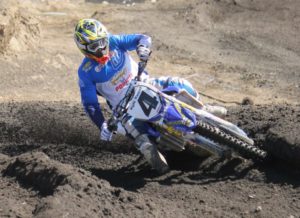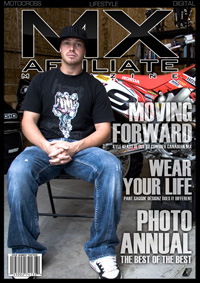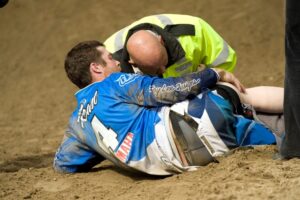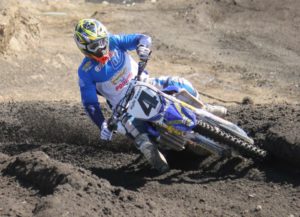By Kerrie Lee Brown
With high hopes, a new team, and advanced training and nutrition programs, Kyle “the Dozer” Keast was set to challenge for a podium position at each race of the 2012 CMRC Monster Energy Motocross Nationals series. Little did Kyle know that in early January he was about to enter “the perfect storm.” The problem was the storm was brewing up against him. In this interview, I sit down with Keast to find out what it takes to overcome one of the toughest years in his professional career – and to understand how he will refocus his energy to make it to the top of the box in 2013 and beyond.
For those reading this who may be new to the sport of motocross, give us some history of when you turned pro and how you got there.
I turned pro in 2002 and I’ve been racing since I was five years old. My dad and uncle used to race so that got me started on the 50s. I competed in the junior class for half a year then went to intermediate, and then shortly after moved up to pro. Junior class went pretty fast for me – whereas normally people are in Juniors for 1-2 years. I moved up quickly. I was in intermediate for one and a half years then turned pro.
What are the biggest challenges when you turn pro?
The biggest challenge going from intermediate to pro is the competition level. The jump is a pretty big step – the level of training, getting into shape, longer motos, making sure your stamina is good. Plus everyone is fast in that class. I also think it’s the pressure that you put on yourself because you’re finally a pro. Getting all the bugs worked out in your riding, getting used to new bikes, and keeping sponsors happy – it’s only after two years or so that you finally know who’s really fast, what to do and who to look out for.
You’re one of the most popular pro motocross athletes on the circuit. What would be your advice for someone coming up to the pros?
Try not to put any more pressure on yourself during your first year in the pro class. But it’s going to happen because at that level most of us want to prove ourselves and succeed in the sport.
Does the pressure come more because you now have sponsors or people who look up to pros?
I’d say it’s because more people are watching. People start to look up to you and you start to want to do good for others not just yourself. There are just a lot more things to manage and focus on because you’re usually juggling work, or school, as well as riding. It’s hard for the first couple years.
This past year you signed a contract to ride for the Yamaha Factory team through Machine Racing. How did that deal get put together and how long is it for?
The contract is from year to year. Brian Hudgins from Yamaha Canada and I are friends and it was a pretty obvious choice. We took our time to put together a program that got me on a bike I have liked for some time. I was also able to negotiate the deal so I didn’t have to run my personal business every day like last year – I could focus 100 percent on getting prepared. I am hoping I’ll be on Yamaha next year too. We’re going to talk in October to see what happens next.
me on a bike I have liked for some time. I was also able to negotiate the deal so I didn’t have to run my personal business every day like last year – I could focus 100 percent on getting prepared. I am hoping I’ll be on Yamaha next year too. We’re going to talk in October to see what happens next.
Moving to the YZ450 from a KTM, what do you think about the bike? How does it suit your riding style?
The ironic thing is that I liked that bike when they first switched the motor in 2010. I had tried that bike when they moved the motor and spun it around. For a lot of people it was hard to get used to – maybe it’s my riding style but for me that bike seemed to suit me well. I guess it was an easy jump and pretty natural. It’s a bigger bike, but the power and ergonomics really fit me well.
This year you started working with ACTIONETIX™ to get prepared for the season. How did that help you and what changes did you focus on?
It was nice to have someone backing me when I had certain questions. Before I used to go to the gym and I thought I worked out the proper way, but there are a lot of things that Craig Stevenson, the owner of ACTIONETIX™, explained to me that I was doing wrong. So he set me up with a training, nutrition and supplement program specific to my riding style, metabolism and fitness level. I don’t mind doing the work but if I don’t know what direction to go in – it just doesn’t work. I always had a good idea of what to eat, but didn’t know the breakdown of calories and protein and how much to have. Craig has been a huge help to me in figuring out proper training and foods for my body. We’ve really worked on fluid intake, salt and potassium balance, as well as how to keep my weight at the proper level while maximizing strength, endurance and recovery.
Have you ever had someone help you with your training in the past?
When I first started training at 18 for the pros, I had a guy help me that  did some MMA stuff and he knew what he was doing, but Craig’s knowledge on how to work out and how to peak yourself properly has done wonders for my riding. Craig knows the sport and works with your body structure and performance level geared to motocross specifically. Craig has certain techniques that have helped with my training overall and that’s been really good. Like I said, I knew how to train in the gym before but never really knew what to do to enhance my performance on the track. I never knew how to peak properly during the season and now I do. My last laps in the moto are just as fast as my first, and that’s from being in shape.
did some MMA stuff and he knew what he was doing, but Craig’s knowledge on how to work out and how to peak yourself properly has done wonders for my riding. Craig knows the sport and works with your body structure and performance level geared to motocross specifically. Craig has certain techniques that have helped with my training overall and that’s been really good. Like I said, I knew how to train in the gym before but never really knew what to do to enhance my performance on the track. I never knew how to peak properly during the season and now I do. My last laps in the moto are just as fast as my first, and that’s from being in shape.
I know you were geared up to head down south last winter to test, but you broke your ankle in January. How did you handle that set back?
It was a huge disappointment – especially the way I did it on a small indoor practice track when I was just having some fun with friends the first month of training. I was feeling really good too and then it happened. At the time when I broke my ankle the plan was to head down south to train within the next two weeks, but that obviously didn’t happen. When you do something like that it puts a huge damper on things. You wonder if your year is ruined, if the season is over, and will I ever get over the setback. It sucked. Later I realized that the ankle injury would linger a lot longer than I expected, because it’s a joint that supports all of your weight every time you walk. It’s not like breaking a collarbone or separating a shoulder or something.
How do you get over something like that right before the season really even starts?
Hopefully you have people around you to keep you positive. The first couple weeks were really hard. I was trying to recoup after surgery but I kept thinking about what I would do next. The best thing I did was keep up with the nutrition side of my program because getting to the gym was a bit difficult. I knew I could keep my bodyweight in line by eating well, which would make the recovery and training that much better and faster.
How much do you think it set you back coming into the West coast portion of the Nationals?
At that point, even if you feel a bit better, it just sits on your mind that you’re still injured. You don’t want to make excuses, but you know that you’re not 100 percent and it sucks. I missed two months of training and felt like crap mentally and physically. To be honest, the only thing you can do is set those thoughts aside and know that you’ve done – or are doing – everything possible without any regrets. An injury sucks but it’s part of the sport.
Have you had other injuries as serious?
I broke my collarbone on the 60s when I was a kid and then on the 80s broke my right ankle. It’s all part of the sport so it didn’t bother me.
Back to your recent injury, I know that broken ankles can be really hard to heal; do you have any advice for riders who have that type of injury?
Listen to your doctor and talk to other riders who have had similar injuries. And don’t be stupid – get that ankle looked at by a professional. Before I met Craig I rarely took my injuries to a doctor and I regret that now – perhaps I would have healed faster or better. I never went to a doctor and asked for advice or did physical therapy. I should have always done the therapy right off the bat. But like I said, if nothing else, you should talk to a specialist and see what the best thing is for a fast, easy recovery because down the road you’ll regret it if you don’t.
Fast-forward to the West coast swing of the Nationals this season. You finish just off the podium in Nanaimo, B.C., which quickly proved that even with a late start you had legitimate speed. Take us through what you were thinking after that race.
Going into the race I still felt injured even though my fitness was up and I was a lot stronger mentally, but Nanaimo has never been one of my best tracks. I was happy with how my results were at that point and was looking forward to Kamloops to a track that suits my riding style. The odd time when I grabbed my ankle in a rut it wasn’t good but I fought through the pain to stay as competitive as I could against the leaders. I felt like I was going to be able to challenge for the podium for the next weekend by that time.
So off you go to round two at Whispering Pines with a few cracked ribs from a training crash and in Moto 1, you show the same speed and finish 4th. In Moto 2 you were really pushing Bobby Kiniry pretty hard and looking to take over the position, when you went down hard. Talk us through that moment and what was going through your mind as you hit the deck.
There was really nothing going through my mind. When I hit the ground I was knocked out. As soon as I came to I felt my leg and just sat there and took a deep breath… everything goes through your mind at that point – you

think of all the work you put in and your sponsors and all the people behind you, routing you on. When it happened I felt like I had basically wasted everyone’s time because it was the second round, we were heading in great direction, and then I broke my leg.
Were you in pain?
No, I wasn’t in pain, I was more mad at the whole situation. I was third coming into that moto for points and so it was pretty emotional. All our hard work was shot down the drain. I was angry about what had happened, and I felt a bit helpless at the same time.
How long were you upset at the situation? How did you get through it and when?
I was angry at myself for probably eight weeks straight thinking about why and how it happened. For the first three days I was in hospital and couldn’t go anywhere and I’m not used to that because I’m always on my bike or at the gym or being active. It was frustrating to say the least. I’m not one to just sit on my ass. I also hated the fact that by then I knew who won the race and how the points were, and that made me mad because I could have been up there in a podium spot. I should have been traveling to the next round. But it’s all part of the sport – you have to accept the good with the bad.
What did you do next?
I stayed at the hotel until I could move around when the swelling finally came down. I stayed at my girlfriend’s house for the next three weeks and basically did nothing. The worst part is that you’re sitting there by yourself and going through the accident in your head over and over and over. I try not to dwell on it but at that time it was hard not to when I knew all the other guys were still out there racing. I just couldn’t help thinking of all my sponsors and the money they put in and everything. I felt a lot of responsibility.
What was your mental state after preparing so hard and knowing you had a legitimate shot at the podium in every race this year?
I always tell myself that it’s part of the sport, but for me this was supposed to be my big year. So I just kept thinking what could I do next. Two bad injuries in one year… what do you do? You pick yourself up and start riding and training again. I’m not one to give up. As soon as I’m back on the bike I’ll be back to normal again.
Soon after you broke your femur, you were still named to the Canadian des Nations team as an alternate. What were your thoughts when you got the call?
I was really excited and scared at the same time because obviously I wanted to go and always wanted to race for Team Canada. I knew coming into the Nationals that I would be one of the three who might be on the team. But when my accident happened I didn’t think I would actually be chosen until I spoke to Carl Bastedo who asked me how long it would take for me to get better – like six months or a year? He then asked me to be the alternate. So from that point on I was determined to get back in the same shape and hit the gym as soon as possible. But was I going to have time to get back in shape on time? I really couldn’t answer that question. I had mixed emotions.
Now that your femur is healed, what are the next steps?
My plans are to get stronger. Everything is healed but still very weak. I just want to take it easy for the fall. My goal is to get back in shape and get riding as soon as possible. Hoping to do this in the next couple weeks. I know I need to build my muscle again so I’ll be training all fall and all winter and hopefully come back strong for the spring. The ironic thing is that the Canadian des Nations team actually got cancelled.
When do you think you’re going to be back in the gym pushing hard?
Over the next few weeks I want to get back at it. I’ve been going to physio and doing my own stretching at home, making sure I’m accelerating my recovery.
Are you planning on heading south this winter to test or will work keep you closer to home?
I’ll probably stay closer to home but if there’s a week I’m free I may drive to Georgia and start riding early. We’ll see.
You’re known as “the dozer” because of your strong physical structure and get-out-of-my-way attitude. We know you shed some pounds this past season…What kind of weight are you looking to enter the 2013 season at to maximize your performance?
I’ll probably do the same thing as I did before last season once I get in the gym and talk to Craig about a program. I’d like to get down to 175 and be a little leaner and still be strong – lose a few more pounds, and get my leg and core strength back up. We were working on getting to that weight this past year, but my ankle injury set me back a bit with training, so we ended up just over 180 pounds which was lighter than the previous few years.
How has HemoAde™ helped with your riding since you’ve started taking it? Do you get arm pump?
To be honest, I get arm pump but I don’t have huge issues with it like a lot of other riders that I know. I usually feel it early in the season or when I’m riding tighter arenacross type tracks. The first and second practices my arms always seem to get a bit pumped. So I started taking HemoAde last December when I was training heavy and then started riding in January – and I never had any signs of arm pump again. I thought maybe it was just a fluke but I truly haven’t had it at all the whole season so it was a huge eye opener. Now I take it every single day because I’ve realized it’s not just good for arm pump but it helps your whole body. I’m a firm believer now and take it every day – it’s pretty impressive when your fingers don’t cease up around the bar when you’re riding 35-minute motos. I haven’t had any issues at all. It’s a cool product.
Would you recommend HemoAde™ to others?
Absolutely. I’ve told a bunch of people and some had already heard of it because it’s come out this year pretty hard in the media. I tell people to at least try it and see what happens, because it has really worked for me. Everyone’s different but there’s no harm in trying the product if you get arm pump or finger cramps. I also tell people to call Craig to ask him more about the scientific reasons behind the formula because it’s pretty cool. Take it for 2-3 weeks and see what happens.
Thanks Kyle for the deep insight, I know your 2012 didn’t quite go as planned, but what positives have you taken away this year and what advice would you give younger riders that may have some setback like you had?
I don’t think it’s the kids that are scared to get injured – it’s more their parents that get scared. If the kids love it enough, like any sport, they’re going to get injured at some point in their career if they’re determined to take it to the next level. That’s why I got hurt because I was pushing myself and trying to improve my skills. It’s going to happen – but there are a lot of safety products out there on the market today so I say take every precaution you can to be safe and smart. But if you enjoy the sport as much as I do, then there’s no reason you should quit over an injury. Your bones will heal. Just go for it but be careful.
Thanks again for your time, Kyle, and good luck with your training for the 2013 season.
For sure! Thanks Kerrie.
